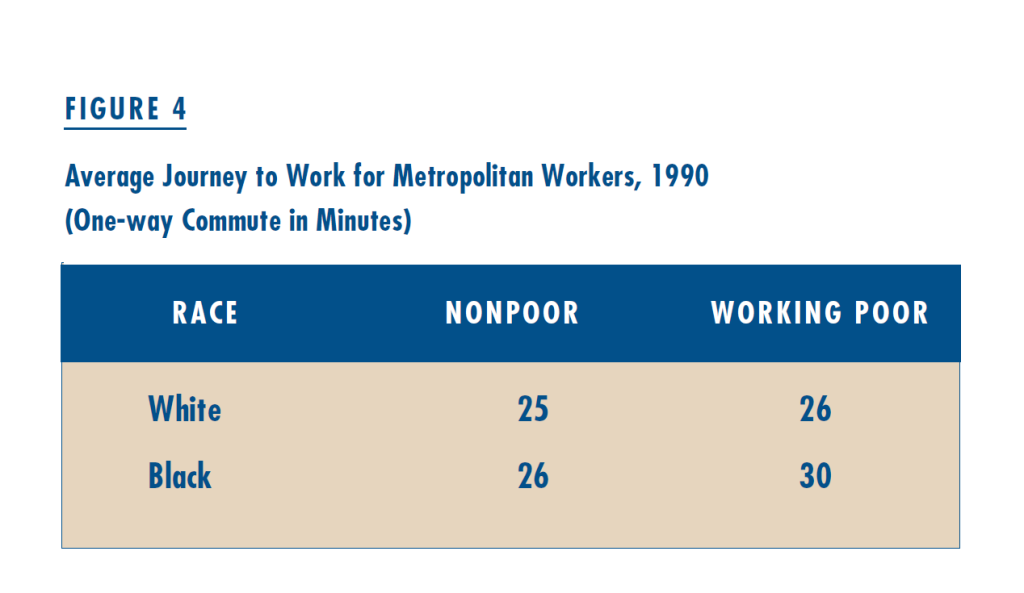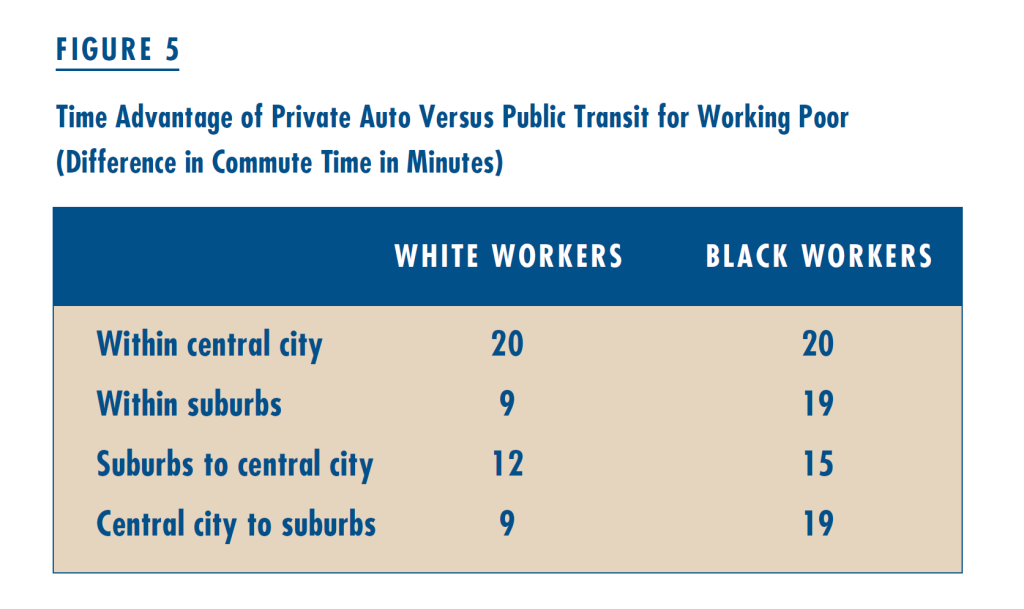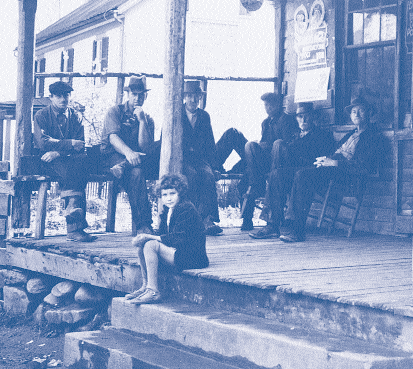Urban jobs continue to migrate away from central cities, while workers are moving to the suburbs. With each passing decade, the commute from home to work has become more dispersed. The historical division of function between central city and suburbs—the central city providing jobs, the suburbs providing residences— no longer holds.
Between 1970 and 1990 the percentage of white workers with central city jobs declined by more than half, from 50 to 20 percent, and the percentage of black workers with central city jobs declined from 61 to 37 percent. The decentralization of residences was even more dramatic. The proportion of white workers living in the central cities of US metropolitan areas declined by 29 percentage points, while the proportion of black workers declined by 42 percentage points. By 1990, only about one out of eight white urban workers was living in a central city.
The ratio of jobs to workers in the central city declined from 1.2 to 1 for whites, while for blacks the ratio declined to 0.7, indicating that a sizable fraction of black workers are reverse commuters—that is, they live in central cities and work in the suburban ring.
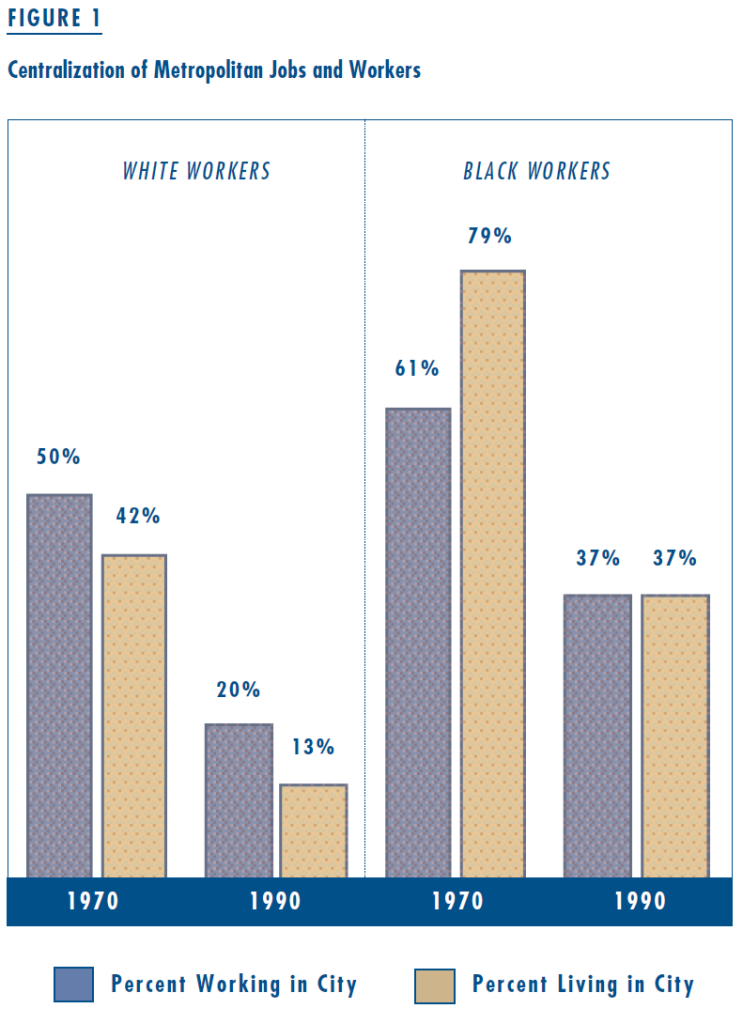
Note that the pattern of changes over time is similar for white and black workers, but the absolute level of centralization is much higher for blacks. The proportion of blacks working in the central city is almost twice as large as the proportion of whites, and the proportion of blacks living in the central city is almost triple the proportion of whites.
This decentralization of worksites and residence sites has radically changed the commuting patterns of the “typical” worker. Figure 2 summarizes some of these changes. The number of nonpoor workers commuting from city residences to city jobs has plummeted. Among white workers, this commuting pattern declined from 33 to 12 percent; among blacks it declined by 30 percentage points. There has been less change in the incidence of commuting from suburban residences to central city jobs.
The big increase, however, has been in the “other” commuting patterns, from suburban residences to suburban worksites or from central city residences to suburban worksites. The incidence of these commutes has increased by 28 percentage points among both white and black workers, almost doubling among black workers. Of course, it is precisely these “other” kinds of worktrip commutes—from dispersed origins to dispersed destinations and “reverse commutes” to the suburbs— where the advantage of auto commuting is most apparent. Public transit systems have the most difficulty supplying service competitively along these low-density routes.
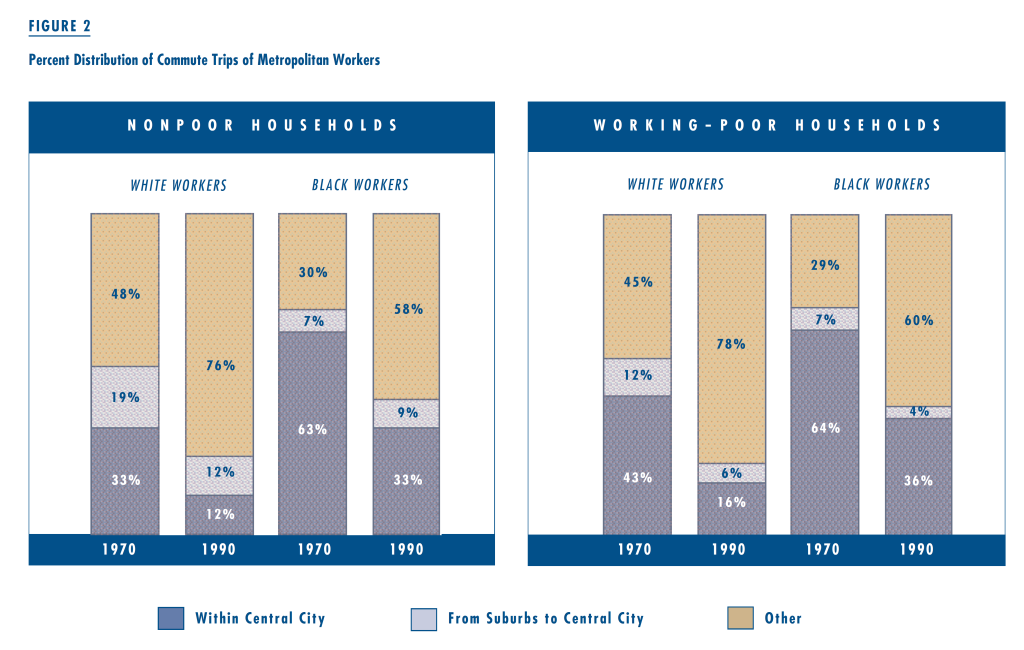
The right panel of Figure 2 summarizes the commuting patterns of workers in poor households (for example, four-person families with total incomes less than about $12,700 in 1990). Although these urbanites, the working poor, are somewhat more likely than the nonpoor to commute between city homes and city jobs, they are also more likely to commute within suburbs and to commute from central city to suburb. Poor white workers are now as likely to make these kinds of commutes as are nonpoor white workers are (78 percent compared to 76 percent). It is also true that poor black workers are as likely to make these kinds of worktrips as are nonpoor black workers (60 percent compared to 58 percent).
Of course, it is precisely among the group of poor workers that auto ownership is lowest. In 1970, 18 percent of US households did not own autos; by 1990, this figure was less than 12 percent. However, based on the 1990 National Personal Transportation Survey, the Department of Transportation estimates that 24 percent of poor households do not own autos, compared to 2 percent of nonpoor. Moreover 62 percent of all those US households who do not own autos can be considered poor or “near poor.” Consider the working poor: 45 percent of black workers living in central cities have no access to cars, and 26 percent of black workers living in the suburbs don’t either.
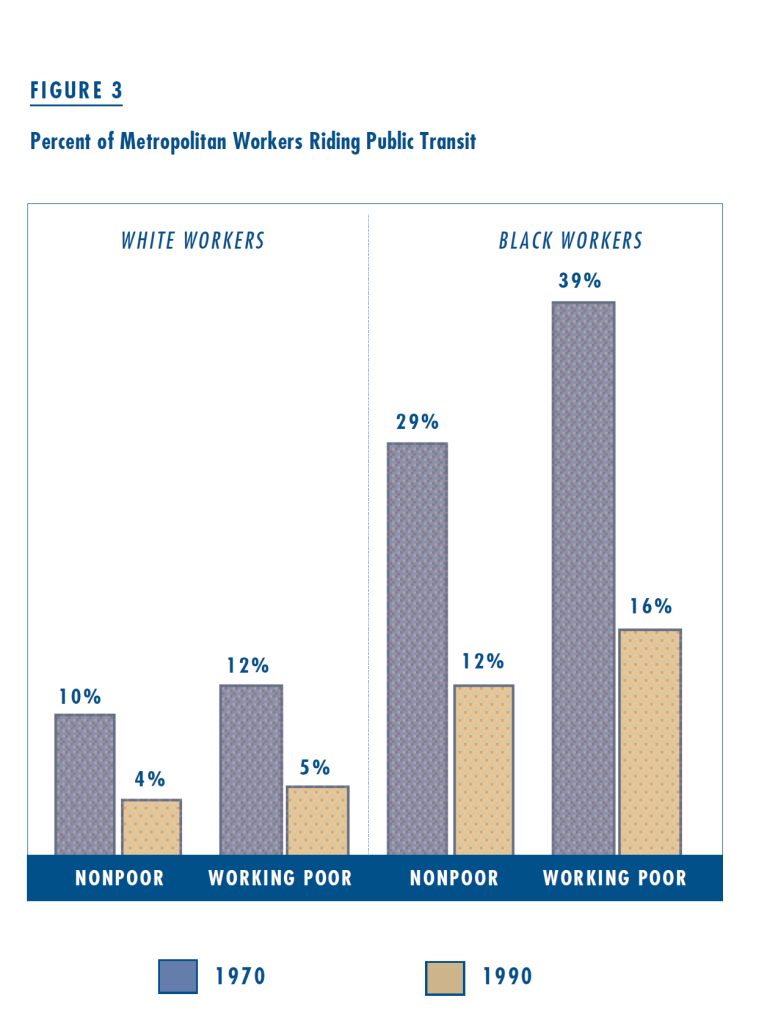
Thus, a substantial fraction of the working poor must use public transit, even though their commutes might be better served by private autos. Figure 3 compares transit riding over time. Changes in origins and destinations have reduced transit usage by more than half among all workers, but the working poor are more likely to commute by public transit. Among black workers, the incidence of public transit usage is a third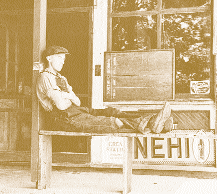 higher for poor workers than for the nonpoor (16 percent compared to 12 percent).
higher for poor workers than for the nonpoor (16 percent compared to 12 percent).
Together, these factors point to somewhat longer commute times for poor households, particularly workers in poor black households. The averages, reported in Figure 4, are indications of these differences. Among blacks, the working poor commute about eight minutes longer each day than the nonpoor. These differences are significant, especially when considering that commute distances typically increase with income.
The averages are also misleading, however, when comparing commutes of those poor having access to autos and those who rely on public transit. Figure 5 suggests that for poor workers most of the commute differences are associated with auto access. The table presents the average difference in commuting times (transit minus auto) for those who take private autos and those who take public transit. The time differentials are large for all types of trips. However, the differences are more than twice as large for blacks who take the most circuitous trips, intra-suburban worktrips or “reverse commutes.”
No Car, No Job?
Of course, comparisons of commuting patterns among the nonpoor and the working poor ignore one potentially important aspect of the availability of transportation alternatives: their effects on getting a job in the first place. For example, in a recent survey of lower-skilled workers in the Detroit area, researchers analyzed the job-search behavior of unemployed workers, finding large differences between the patterns of those who owned cars compared with those who did not. Those with cars searched for work over a wider area and range of neighborhoods, and this increased breadth was reflected in the number, type, and character of job opportunities discovered.
Differences in auto ownership also seem to have affected success in a recent program intended to improve employment outcomes for noncustodial fathers of welfare-recipient children. Participants in the program were offered extensive job and training assistance. An analysis of program attrition was conducted by the Manpower Demonstration Research Corporation (MDRC). The MDRC report concluded that auto ownership was an “important prerequisite” to participation in the program, to completion of the job-training program, and ultimately to getting jobs.
Studying how unemployed persons search for jobs and how the working poor commute to urban jobs may help clarify potential problems in reforming the welfare system to increase work incentives. If potential commute patterns of people coming off public assistance are similar to those of people currently in poor working households, government policy must pay more attention to auto ownership opportunities. Under the old welfare system, the federal government had imposed strict asset limitations upon welfare recipients, limiting their ability to own cars. Now design and enforcement of these regulations are left to the states. So programs that help job takers obtain a used car— a secured loan for purchase, a leasing scheme, a revolving credit arrangement—may offer real promise, particularly in less dense and less centralized urban areas.
It is hard enough for those without high levels of skill and without extensive work histories to find jobs that can pay for child care and leave enough left over for survival. We should facilitate a reduction in their transport costs, promoting the mass transport system that works so well for the nonpoor—the private auto.
Further Readings
Broack, Thomas, et al., “Creating New Hope: Implementation of a Program to Reduce Poverty and Reform Welfare,” Manpower Demonstration Research Company, New York, October 1997.
Lave, Charles and Richard Crepeau, “Travel by Households Without Vehicles,” National Personal Transportation Survey: Travel Mode Special Reports, US Department of Transportation, December 1994.
O’Regan, Katherine M. and John M. Quigley, “Accessibility and Economic Opportunity,” 1998, UCTC No. 362.


